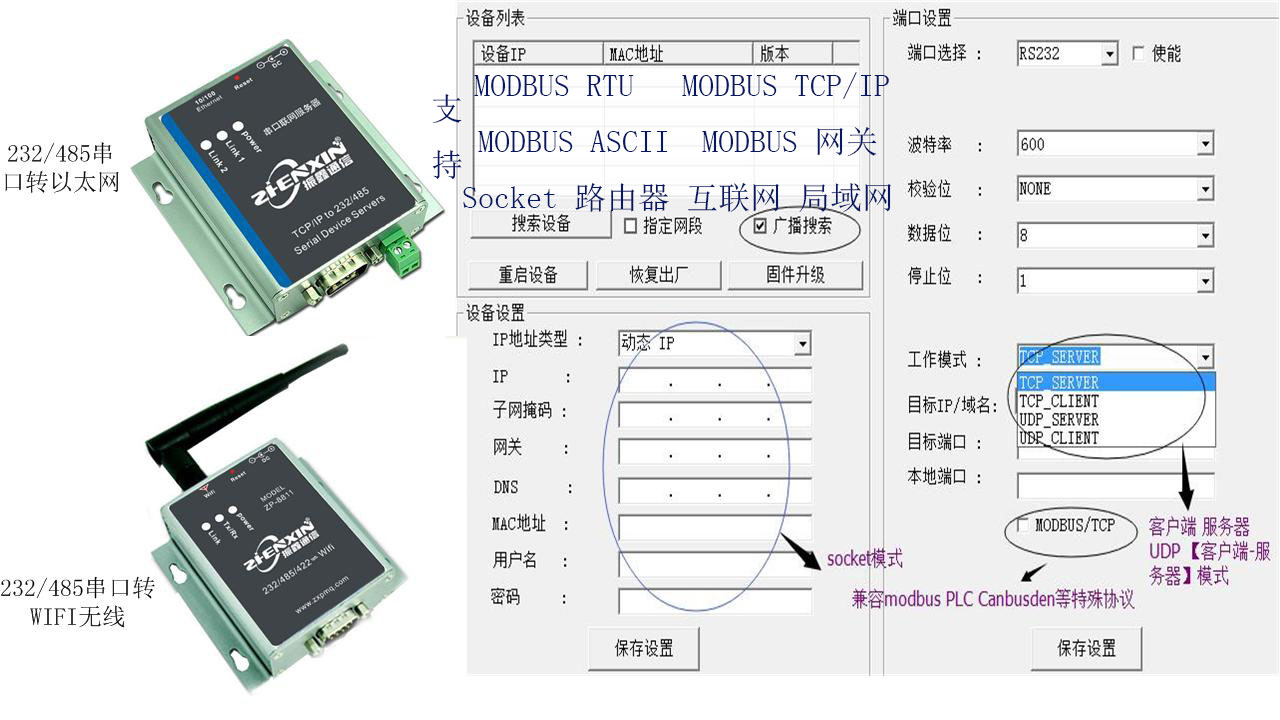The client is usually the request of the sender, send the request to accept the results of the server; server is to accept the client request, in the data processing, to send the relevant data to the client; that white, who will set what function to take the initiative to send Data that is the server side, the data issued by the client who is to receive! Master - slave relationship: the server to send information, the client to receive information;
Note: The following configuration is only applicable to the company's serial server, has purchased different models of specific configuration methods can consult the relevant technical staff.
First, ZP-8621 / ZP-8111 and other network work mode
ZP-8621 / ZP-8111 [TCP / IP Server mode]
In TCP Server mode, the serial server first tries to communicate with the gateway, and then listens to the set local port. When there is a connection request, the serial server responds and creates a connection. Up to four links exist at the same time. After receiving the data, the serial port will send the data to all The serial server establishes the linked device. The serial server listens on the TCP / IP port and waits for a connection, and the connection to the serial port server can be a computer or other embedded network device.
ZP-8621 / ZP-8111 [TCP / IP Client mode]
In TCP client mode, after the serial server power on according to their own settings to take the initiative to connect to the TCP server server, and then establish a long connection, after the data for transparent transmission. In this mode, the IP of the TCP server needs to be visible to the serial server. The serial server initiates a connection to the specified remote host TCP / IP port according to the settings, which must work in Server mode.
ZP-8621 / ZP-8111 【UDP broadcast mode】
In UDP mode, the serial port server after the power to monitor the set port, do not take the initiative to establish a connection, when there is data over, forwarded to the serial port, when the serial data received through the network to the serial server to set the IP and port. Mode, the serial server will use UDP broadcast mode for data communication, the default settings, the data will be sent to the broadcast using UDP address: 255.255.255.255: 8001, while the serial server from address: 255.255.255.255: 8001 to receive data, the user You can also modify these parameters as needed. This mode can implement a single virtual serial port and a number of serial server communication program. You can also achieve a serial server to send multiple serial server to receive a one-to-many transparent solution.
ZP-8621 / ZP-8111 [UDP Server mode]
UDP server is based on the normal UDP does not verify the source IP address, UDP packets received after the target IP to data source IP, similar to the TCP server function.

Second, cross-network access to the serial port server to specify a valid gateway address, you can achieve on the serial server cross-network access. TCP / IP Server, Client mode supports cross-network access.
ZP-8621 / ZP-8111 [TCP / IP Server mode]
Set the gateway address of the serial server as the IP address of the active gateway. Set the NAT rules on the gateway, map the IP address and listening port of the serial port server to a TCP / IP port on the gateway, and connect to the port on the gateway to establish the communication with the serial server.
ZP-8621 / ZP-8111 [TCP / IP Client mode]
Set the gateway address of the serial server as the IP address of the active gateway. And the serial server to specify the remote host address to connect, if set correctly, the serial server can be established through the gateway and remote host TCP / IP connection
ZP-8621 / ZP-8111 【UDP broadcast mode】
In most cases, UDP broadcasts are not cross-networked.
Third, the serial work mode
Stream forwarding mode, received that is forwarded.
After receiving the data from the serial port, the serial port will forward the data to the corresponding TCP / IP connection immediately. The serial port will not wait for any buffer, fast and efficient. However, when the serial port service communicates with the serial server in Sokcet mode, The software itself for data frame reorganization, otherwise there will be unpacking phenomenon.
Adaptive data frame, storage and forwarding mode
In this mode of operation, the serial server will forward a complete data frame to a TCP / IP connection after receiving a complete data frame. By the serial server to complete the serial data frame reorganization.
The serial server determines whether or not a complete data frame has been received based on the interval between the data frames.
When no new serial data is received within the specified frame interval, it is assumed that a complete data frame is received and the data frame will be forwarded to the TCP / IP connection at one time.
